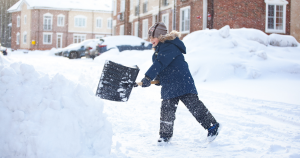Winter Mayhem! Common Snow Shoveling Injuries and Treatment Options
 As the winter season gets into full swing, it’s inevitable that most people living in a winter weather climate will find themselves outside, with a shovel, clearing away snow. This task can be quite physically demanding, especially after a heavy snowstorm. While there are several steps you can take to avoid injury, often snow shoveling-related injuries are unavoidable.
As the winter season gets into full swing, it’s inevitable that most people living in a winter weather climate will find themselves outside, with a shovel, clearing away snow. This task can be quite physically demanding, especially after a heavy snowstorm. While there are several steps you can take to avoid injury, often snow shoveling-related injuries are unavoidable.
Orthopaedic Hospital of Wisconsin physical therapist David Tranchita, MA, PT, CMTPT, CSCS, of Greenfield and New Berlin Physical Therapy, describes the most common injuries you may experience snow shoveling and a few tips to avoid these injuries. And if you find yourself injured, Tranchita overviews a few treatment options that can help you find relief.
What Are The Most Common Injuries Which Can Occur While Shoveling?
 Most snow-related injuries happen after overexertion or slipping on the ice while shoveling. While acute musculoskeletal exertion — in other words, overworking your muscles — accounts for most shoveling-related injuries, some are due to slips and falls. Regardless of the cause, it’s no surprise that injuries to the back are the most frequent. The average person with a double driveway will shovel between 1,100 and 1,500 pounds of snow after a snowfall of six inches (do the math – the length of your driveway times the width of your driveway times the height of the snow in inches). Repeated movement can be hard on your back, especially your lower back. Here are the five most common snow shoveling injuries you’ll need to watch out for:
Most snow-related injuries happen after overexertion or slipping on the ice while shoveling. While acute musculoskeletal exertion — in other words, overworking your muscles — accounts for most shoveling-related injuries, some are due to slips and falls. Regardless of the cause, it’s no surprise that injuries to the back are the most frequent. The average person with a double driveway will shovel between 1,100 and 1,500 pounds of snow after a snowfall of six inches (do the math – the length of your driveway times the width of your driveway times the height of the snow in inches). Repeated movement can be hard on your back, especially your lower back. Here are the five most common snow shoveling injuries you’ll need to watch out for:
-
LOWER BACK PAIN OR STRAIN
Poor posture and a rounded back contribute to lower back pain. Poor posture will cause you to do more work with weaker muscles and put stress on your spine. Always shovel snow using a combination of legs, arms, and back muscles, so make sure to keep a straight back, lift with your knees and push snow rather than lift it whenever possible.
-
HERNIATED DISCS
A bulging or herniated disc occurs when one of the discs in your spine moves out of alignment and pinches a nearby nerve. These injuries are prevalent during heavy snowfall when shovelers attempt to lift heavier loads. If you twist your spine instead of practicing a fluid up-and-down motion, you might slip a disc. To prevent slipped discs, keep your knees perpendicular to the snow. Lift and pivot or walk toward your pile to deposit it. Try to avoid throwing snow over your shoulders or to the side. While this may feel like a time-saver, you’re much more likely to throw your back out shoveling snow this way.
-
FRACTURES, TORN LIGAMENTS OR TENDONS, AND BRUISING
A bad fall onto hard asphalt can fracture or bruise your backbones and tear the connective tissue around the spine. When it is wet and cold, pay special attention to icy areas and move with caution. Wear snow boots with good treads to aid your grip and spread sand, salt, or kitty litter on the sidewalk and driveway to increase your traction.
-
SCIATICA
While not technically an injury, sciatica, or radiating nerve pain down the leg, can be exacerbated by activities such as shoveling snow. Herniated discs and muscle spasms can cause sciatica, and treating these conditions can help you find relief. Cold weather puts you at greater risk for muscle strain, which can activate sciatic pain. Any sudden movement or heavy lifting, like removing snow, can also worsen sciatica. Warm up properly with light active stretching before the activity, wear warm clothing (layers), and maintain fluid movements using proper body mechanics.
What Should You Do After A Snow Shoveling Injury?
Taking the precautions above should help you shovel snow pain-free. But what do you do if you throw out your back or slip and fall?
The first step is to determine how severe your injury is. Are you experiencing muscle soreness or something more? If you suspect a fracture or an injury to the spine, you should seek immediate medical attention and go to the emergency room. If it’s not an emergency, there are a few things to do to relieve your pain.
Some minor low back pain or soreness after shoveling snow is not usually something to worry about. If it persists for more than a few days, consider making an appointment with your doctor or physical therapist for an evaluation and treatment. However, here are some steps to relieve the general soreness of muscles after shoveling snow.
-
ALTERNATE COLD AND HOT
Initially, after an injury or muscle soreness, ice can help reduce pain and inflammation, as it is an anti-inflammatory. We recommend applying ice for 20 minutes at a time for 2-3x/day. After three days, if you experience less pain and more stiffness, heat can help increase blood flow and relax tight muscles.
-
GENTLY EXERCISE THE AFFECTED MUSCLES
When you’re in pain from overworking your muscles, it may sound counterintuitive to get them moving again. While rest is essential to recovery, some exercise will keep your muscles loose and break up knots. Try some light stretching to the targeted painful area.
A massage or foam roller will soothe tender and stiff muscles. Extension-type exercise movements (opposite of bending forward and shoveling snow) can relieve back muscle pain.
-
GET SOME REST
If you’re feeling sore after shoveling snow, rest can help your muscles recover. Avoid more shoveling or any activity that forces you to move these same muscles. It is normal to feel sore even three days after shoveling, so taking it easy for those first few days can help you bounce back.
If your pain persists for more than 72 hours, it’s time to seek medical help and consult your physician or physical therapist for treatment guidance. The orthopedic specialists at Orthopaedic Hospital of Wisconsin are here to help. To make an appointment, go online or call 414.961.6800.

